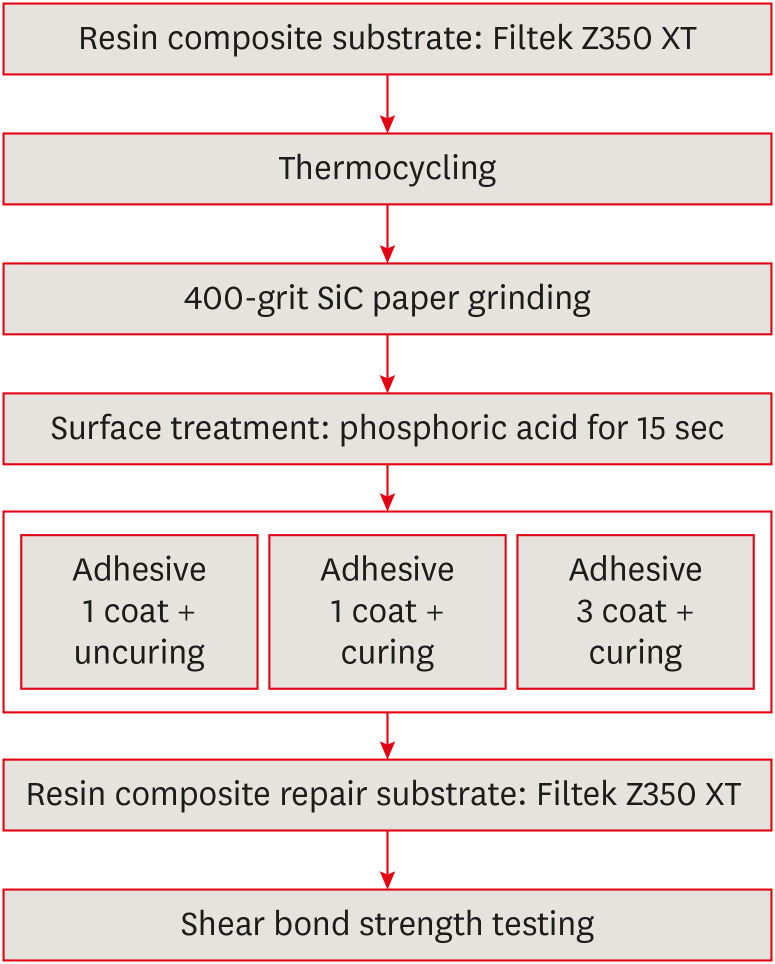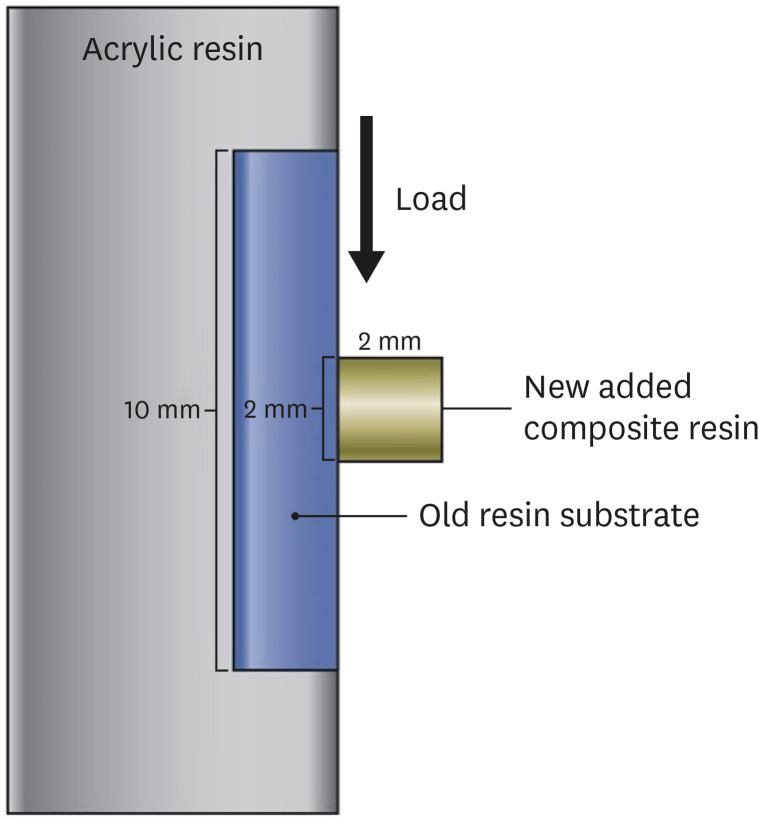Restor Dent Endod.
2021 Aug;46(3):e32. 10.5395/rde.2021.46.e32.
Effect of adhesive application method on repair bond strength of composite
- Affiliations
-
- 1Department of Conservative Dentistry, Graduate School, Dankook University College of Dentistry, Cheonan, Korea
- KMID: 2548076
- DOI: http://doi.org/10.5395/rde.2021.46.e32
Abstract
Objectives
This study aimed to evaluate the effect of the application method of universal adhesives on the shear bond strength (SBS) of repaired composites, applied with different thicknesses.
Materials and Methods
The 84 specimens (Filtek Z350 XT) were prepared, stored in distilled water for a week and thermocycled (5,000 cycles, 5°C to 55°C). They were roughened using 400-grit sandpapers and etched with phosphoric acid. Then, specimens were equally divided into 2 groups; Single Bond Universal (SU) and Prime&Bond Universal (PB). Each group was subdivided into 3 subgroups according to application methods (n = 14); UC: 1 coat + uncuring, 1C: 1 coat + curing, 3C: 3 coats + curing. After storage of the repaired composite for 24 hours, specimens were subjected to the SBS test and the data were statistically analyzed by 2-way analysis of variance and independent t-tests. Specimens were examined with a stereomicroscope to analyze fracture mode and a scanning electron microscope to observe the interface.
Results
Adhesive material was a significant factor (p = 0.001). Bond strengths with SU were higher than PB. The highest strength was obtained from the 1C group with SU. Bonding in multiple layers increased adhesive thicknesses, but there was no significant difference in SBS values (p = 0.255). Failure mode was predominantly cohesive in old composites.
Conclusions
The application of an adequate bonding system plays an important role in repairing composite resin. SU showed higher SBS than PB and the additional layers increased the adhesive thickness without affecting SBS.
Figure
Reference
-
1. Brantley CF, Bader JD, Shugars DA, Nesbit SP. Does the cycle of rerestoration lead to larger restorations? J Am Dent Assoc. 1995; 126:1407–1413. PMID: 7594013.
Article2. Fernández E, Martín J, Vildósola P, Oliveira Junior OB, Gordan V, Mjor I, Bersezio C, Estay J, de Andrade MF, Moncada G. Can repair increase the longevity of composite resins? Results of a 10-year clinical trial. J Dent. 2015; 43:279–286. PMID: 24907560.
Article3. Moncada G, Martin J, Fernández E, Hempel MC, Mjör IA, Gordan VV. Sealing, refurbishment and repair of class I and class II defective restorations: a three-year clinical trial. J Am Dent Assoc. 2009; 140:425–432. PMID: 19339531.
Article4. Baur V, Ilie N. Repair of dental resin-based composites. Clin Oral Investig. 2013; 17:601–608.
Article5. Rathke A, Tymina Y, Haller B. Effect of different surface treatments on the composite-composite repair bond strength. Clin Oral Investig. 2009; 13:317–323.
Article6. Ahmadizenouz G, Esmaeili B, Taghvaei A, Jamali Z, Jafari T, Amiri Daneshvar F, Khafri S. Effect of different surface treatments on the shear bond strength of nanofilled composite repairs. J Dent Res Dent Clin Dent Prospect. 2016; 10:9–16.
Article7. Loomans BA, Cardoso MV, Roeters FJ, Opdam NJ, De Munck J, Huysmans MC, Van Meerbeek B. Is there one optimal repair technique for all composites? Dent Mater. 2011; 27:701–709. PMID: 21571359.
Article8. Loomans BA, Cardoso MV, Opdam NJ, Roeters FJ, De Munck J, Huysmans MC, Van Meerbeek B. Surface roughness of etched composite resin in light of composite repair. J Dent. 2011; 39:499–505. PMID: 21571031.
Article9. Swift EJ Jr, LeValley BD, Boyer DB. Evaluation of new methods for composite repair. Dent Mater. 1992; 8:362–365. PMID: 1303383.
Article10. Lucena-Martín C, González-López S, Navajas-Rodríguez de Mondelo JM. The effect of various surface treatments and bonding agents on the repaired strength of heat-treated composites. J Prosthet Dent. 2001; 86:481–488. PMID: 11725276.
Article11. Fornazari IA, Wille I, Meda EM, Brum RT, Souza EM. Effect of surface treatment, silane, and universal adhesive on microshear bond strength of nanofilled composite repairs. Oper Dent. 2017; 42:367–374. PMID: 28402733.
Article12. Hisamatsu N, Atsuta M, Matsumura H. Effect of silane primers and unfilled resin bonding agents on repair bond strength of a prosthodontic microfilled composite. J Oral Rehabil. 2002; 29:644–648. PMID: 12153453.
Article13. Söderholm KJ, Roberts MJ. Variables influencing the repair strength of dental composites. Scand J Dent Res. 1991; 99:173–180. PMID: 2052899.
Article14. Alex G.Universal adhesives: the next evolution in adhesive dentistry? Compend Contin Educ Dent. 2015; 36:15–26. PMID: 25822403.15. Nagarkar S, Theis-Mahon N, Perdigão J. Universal dental adhesives: current status, laboratory testing, and clinical performance. J Biomed Mater Res B Appl Biomater. 2019; 107:2121–2131. PMID: 30637932.
Article16. Yoshihara K, Nagaoka N, Sonoda A, Maruo Y, Makita Y, Okihara T, Irie M, Yoshida Y, Van Meerbeek B. Effectiveness and stability of silane coupling agent incorporated in ‘universal’ adhesives. Dent Mater. 2016; 32:1218–1225. PMID: 27461880.
Article17. Chowdhury AF, Saikaew P, Alam A, Sun J, Carvalho RM, Sano H. Effects of double application of contemporary self-etch adhesives on their bonding performance to dentin with clinically relevant smear layers. J Adhes Dent. 2019; 21:59–66. PMID: 30799472.18. Zecin-Deren A, Sokolowski J, Szczesio-Wlodarczyk A, Piwonski I, Lukomska-Szymanska M, Lapinska B. Multi-layer application of self-etch and universal adhesives and the effect on dentin bond strength. Molecules. 2019; 24:345.
Article19. Eliasson ST, Tibballs J, Dahl JE. Effect of different surface treatments and adhesives on repair bond strength of resin composites after one and 12 months of storage using an improved microtensile test method. Oper Dent. 2014; 39:E206–E216. PMID: 24807815.
Article20. Eliasson ST, Dahl JE. Effect of curing and silanizing on composite repair bond strength using an improved micro-tensile test method. Acta Biomater Odontol Scand. 2017; 3:21–29. PMID: 28642928.
Article21. Brosh T, Pilo R, Bichacho N, Blutstein R. Effect of combinations of surface treatments and bonding agents on the bond strength of repaired composites. J Prosthet Dent. 1997; 77:122–126. PMID: 9051597.
Article22. Imbery TA, Gray T, DeLatour F, Boxx C, Best AM, Moon PC. Evaluation of flexural, diametral tensile, and shear bond strength of composite repairs. Oper Dent. 2014; 39:E250–E260. PMID: 25084105.
Article23. Cardoso MV, de Almeida Neves A, Mine A, Coutinho E, Van Landuyt K, De Munck J, Van Meerbeek B. Current aspects on bonding effectiveness and stability in adhesive dentistry. Aust Dent J. 2011; 56(Suppl 1):31–44. PMID: 21564114.
Article24. Valente LL, Sarkis-Onofre R, Goncalves AP, Fernandez E, Loomans B, Moraes RR. Repair bond strength of dental composites: systematic review and meta-analysis. Int J Adhes Adhes. 2016; 69:15–26.
Article25. Ausiello P, Apicella A, Davidson CL. Effect of adhesive layer properties on stress distribution in composite restorations--a 3D finite element analysis. Dent Mater. 2002; 18:295–303. PMID: 11992906.
Article26. Wendler M, Belli R, Panzer R, Skibbe D, Petschelt A, Lohbauer U. Repair bond strength of aged resin composite after different surface and bonding treatments. Materials (Basel). 2016; 9:547.
Article27. Della Bona A, van Noort R. Shear vs. tensile bond strength of resin composite bonded to ceramic. J Dent Res. 1995; 74:1591–1596. PMID: 7560421.
Article28. Versluis A, Tantbirojn D, Douglas WH. Why do shear bond tests pull out dentin? J Dent Res. 1997; 76:1298–1307. PMID: 9168864.
Article29. 3M ESPE. Scotchbond Universal Technical Product Profile [Internet]. St. Paul, MN: 3M ESPE;2013. cited 2019 Nov 25. Available from: http://multimedia.3m.com/mws/media/754751O/scotchbond-universal-adhesive-technical-product-profile.
- Full Text Links
- Actions
-
Cited
- CITED
-
- Close
- Share
- Similar articles
-
- Effect of intermediate resin hydrophilicity on bond strength of single step adhesive
- Influence of adhesive application on shear bond strength of the resin cement to indirect resin composite
- Bond strength of self-adhesive resin cements to composite submitted to different surface pretreatments
- Influence of Application Method on Shear Bond Strength and Microleakage of Newly Developed 8th Generation Adhesive in Primary Teeth
- Effect of various intraoral repair systems on the shear bond strength of composite resin to zirconia





